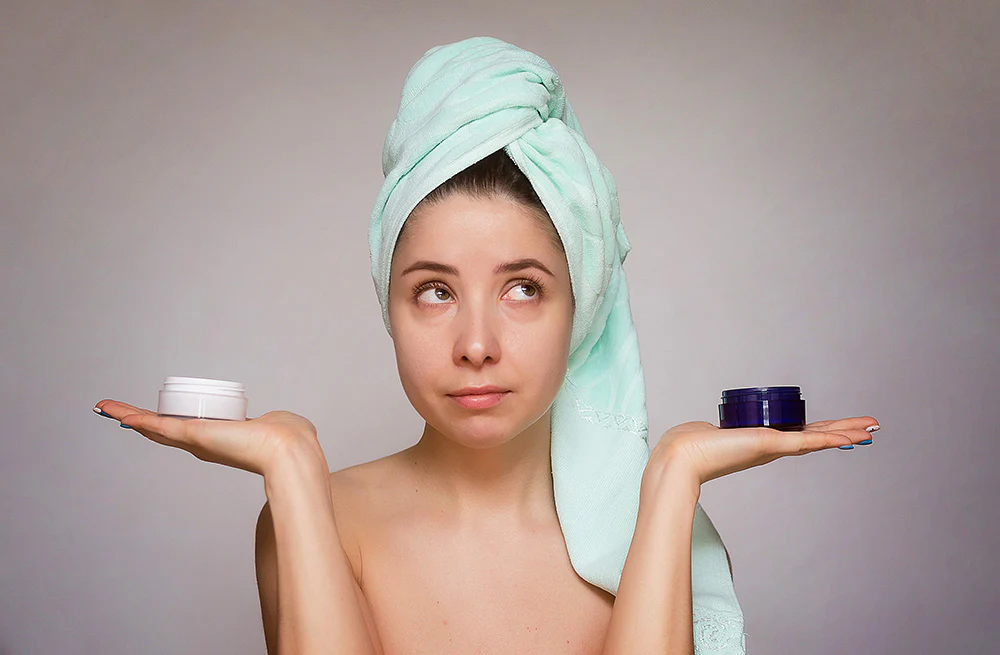
10% Azelaic Acid vs. 14% Azelaic Acid: What’s the Real Difference?
Most over-the-counter products containing azelaic acid, including Paula’s Choice® and The Ordinary®, contain no more than 10% of the active ingredient. For some people, this concentration isn’t enough to produce real results in lightening dark spots and clearing up acne.
To get a higher percentage of active ingredient, many people turn to prescription azelaic acid, which typically contains 15-20% active ingredient. However, some people experience dryness and irritation at higher concentrations. At Foundation Skincare, we’ve found that 14% is just the right amount to significantly improve skin health without causing irritation. Read on to learn more about the benefits of azelaic acid and how to choose the right strength.
What is Azelaic Acid?
Azelaic acid is a naturally occurring dicarboxylic acid that is commonly found in wheat, barley, and other grains. It’s also produced by a type of fungus on the skin. With powerful antimicrobial, antioxidant, and anti-inflammatory properties, azelaic acid is very effective at neutralizing free radicals, helping to reduce acne breakouts, soothe irritation, and slow protein buildup on the skin.
At the same time, azelaic acid acts as a tyrosinase inhibitor. 1 Tyrosinase is an enzyme responsible for the synthesis of melanin, which creates pigment in the skin. By inhibiting this phenomenon, azelaic acid helps eliminate hyperpigmentation and lightens the skin.
There is some evidence that azelaic acid may also help reduce signs of premature aging. Combined with other skin-nourishing nutrients like vitamins C, E, and A, azelaic acid is clinically proven to improve skin elasticity and flexibility, reduce wrinkles, and even out skin tone. 2
Azelaic acid: various strengths
When it comes to choosing an azelaic acid strength, the decision may depend on your specific skin concerns and needs.
Prescription products may seem like a better option because they have a higher concentration, but this is not always the case, especially if you have sensitive skin. At the same time, using a lower concentration may not produce noticeable results. Here are some tips for choosing the right concentration for your skin.
Benefits of 10% Azelaic Acid
Dermatologists agree that prescription products are generally better than over-the-counter products because they contain higher concentrations of azelaic acid, but the 10% concentration may still be effective for some users. 3 Most studies have focused on higher prescription concentrations, but we found some lower percentages of positive results.
For example, in a 2021 study, patients with mild to moderate acne had a 36.51% success rate after eight weeks using a 10% azelaic acid gel, compared to a 30.37% success rate for patients using a 20% azelaic acid cream. 4 Lower concentrations are also safer, with one patient using the 20% cream experiencing an adverse reaction.
The researchers explained that the benefits of using lower concentrations are more related to avoiding side effects observed with higher concentrations, such as burning, stinging, itching, dry skin, erythema, and irritation.
Azelaic Acid 14% Cream
Azelaic Acid 14% Cream
• Reduces acne and rosacea
• Brightens skin tone and fades brown spots
• Unclogs pores and improves skin texture
Regular Price $45
Add to Cart
Benefits of 14% Azelaic Acid
Although the above studies show that azelaic acid in a 10% concentration is slightly more effective and generally safer than a 20% cream for treating acne, it appears to be just as effective for treating other skin conditions, such as hyperpigmentation and premature aging. It is recommended to use a slightly higher concentration of 14% rather than opting for 20% and risking side effects.
Most studies of the slightly higher concentration used products containing 15% azelaic acid, but this concentration is only available by prescription, so the 14% concentration found in over-the-counter products is ideal.
In a 2021 study, patients who used 15% azelaic acid experienced a significant reduction in inflammatory lesions and redness associated with rosacea. 5 No irritation or related side effects were found. Patients using 15% azelaic acid also experienced significant reductions in acne scarring after six months of using the product. 6 Higher concentrations of azelaic acid have also been shown to help reduce wrinkles and fine lines, according to a 2022 study 0.7
Important Differences
The most important difference between 10% and 14% azelaic acid is that the higher the concentration, the more conditions it can treat. However, using higher concentrations (especially 20%, the typical prescription strength) may cause side effects such as irritation. Most higher concentrations above 14% also require a visit to a dermatologist to obtain a prescription.
Benefits of 10% Azelaic Acid:
Effective in reducing mild to moderate acne
Less irritating than products with 20% Azelaic Acid
Benefits of 14% Azelaic Acid:
Effective for treating acne, acne scars, hyperpigmentation, rosacea, and premature aging
Highest percentage available without a prescription
Less irritating than the 20% concentration, especially when combined with soothing and moisturizing ingredients like aloe leaf juice and jojoba oil (found in Foundation Skincare’s Azelaic Acid 14% Cream)
Applications of Azelaic Acid
Foundation Skincare’s Azelaic Acid 14% Cream is for those struggling with acne, rosacea, hyperpigmentation, and premature aging. It was formulated by dermatologists as a cream that can be used daily without irritating the skin like many serums and gels. Other ingredients, like jojoba oil, avocado oil, and aloe leaf, provide soothing effects. At the medical-grade concentration of 14%, you may need to increase usage to twice daily as your skin adjusts. It also pairs well with other products in your base skincare line. We recommend starting with the following routine:
Morning:
Cleanse skin and pat dry.
Apply additional serums such as: B. Niacinamide Lotion 10% to soothe skin and aid in DNA repair. Azelaic acid also pairs well with Vitamin C Lotion 20% to increase firmness and elasticity while brightening skin.
Moisturize with Hyaluronic Acid Lotion, which acts like a magnet to attract moisture to the skin.
Apply a thin layer of 14% Azelaic Acid Cream to kill bacteria and reduce redness and inflammation.
Protect with a mineral broad-spectrum sunscreen with an SPF of at least 30+ (preferably 50).
Evening
Cleanse and apply 10% Niacinamide Lotion.
Hydrate and regenerate your skin with a night cream containing 2% Granactive™ Retinoid to improve skin texture.
You may also consider taking supplements to support your skin health from the inside out. If hyperpigmentation is your primary concern, try Foundation Skincare’s Pigmentation Defense, which contains a special blend of antioxidants, vitamins and herbs to further improve visible signs of skin discoloration. Or use Foundation Skincare’s Spectrum supplement to support skin renewal and prevent further sun damage with plant-based antioxidants and essential vitamins like vitamin D and oral niacinamide.
Choose the Strength That’s Right for You
No two people have the same skin concerns. Starting with a 14% concentration is the ideal way to see if azelaic acid is right for your skin. It gives you the advantage of a higher concentration of active ingredients without a prescription, but the formula is gentle enough for even the most sensitive skin.
Learn more about the benefits of azelaic acid and find more skin care tips in FS Journal.


